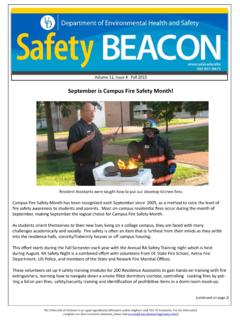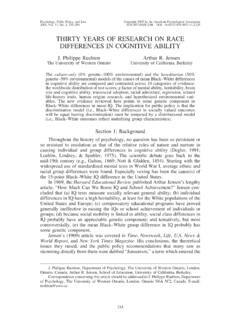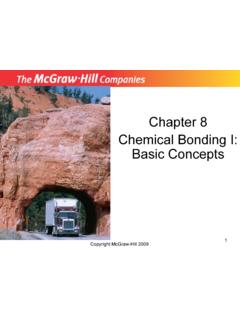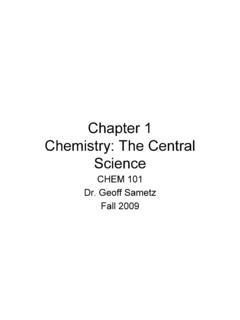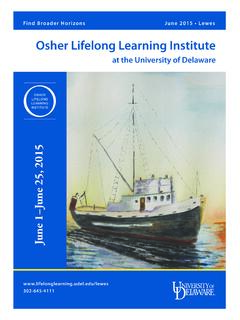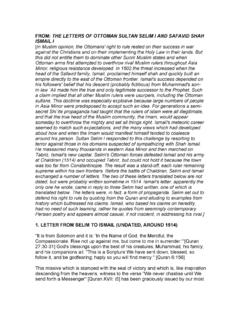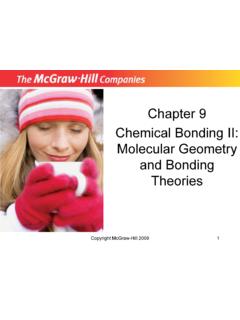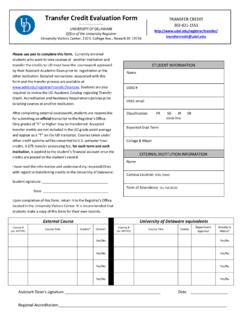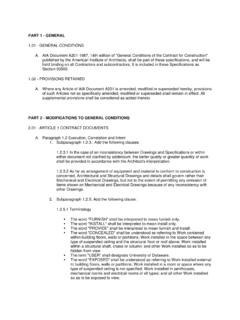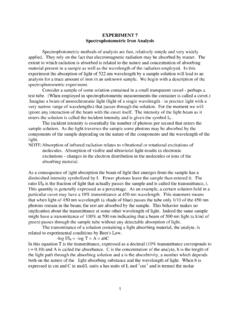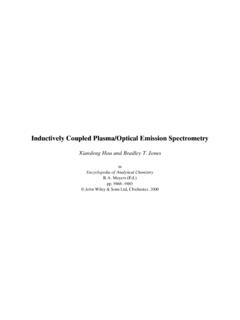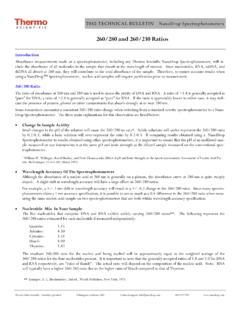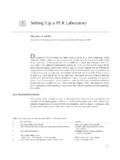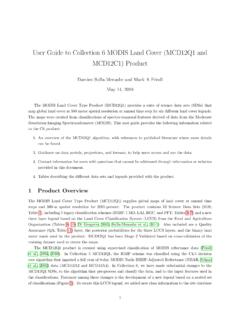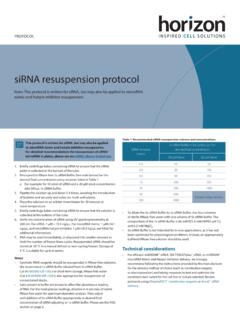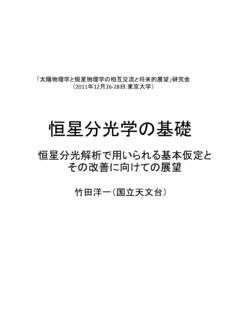Transcription of Molecular Term Symbols - University of Delaware
1 MolecularTermSymbols15thMay 2008I. TermSymbolsforMolecules:ApplyingMODiagra msExcitationsbetweenmolecularelectronics tatesprovideinformationaboutpropertiesof EngelandReid,molecularelectronictransiti onsareinducedby UV/VISradiation,andso thesetransitionsin-volve much moreenergycomparedtothevibrational-rotat ionalspectro-scopiesthatrequiremicrowave ,much asin thecaseof IRspectroscopy, electronicspectroscopy of moleculesincludesa " nestructure"arisingfromvibrational-rotat ionaltransitionsassociatedwithchangesin , we willinvestigatethedescriptionof molecularelectronicstatesin termsofmoleculartermsymbolsas inthecaseof thefactthatmultiplestatesarepossiblegive na particularmolecularelectroniccon , moredetaileddiscussionof theimpor-tanceof orbitalandspinangularmomentumin determiningtheenergeticsof atoms(andmolecules).
2 MolecularTermSymbols:DiatomicMolecules Aswithatoms,MLandMSarethe"good"quantumnu mbers(LandScommutewithHamiltonianfordiat omicmolecules Onlyun lledsubshellscontributeto thetermorbitalandspinan-gularmomentum For rstandsecondrow diatomics,MO'sareeitherof or MLandMSaregeneratedas follow:{ML=Pimli{MS=Pimsi For MO'swith symmetry,ml= 0 For MO'swith symmetry,ml= 1{Notethatthereis noml= 0 for MO'ssincethePzatomicorbitalis associatedwiththe MO Asin theatomiccase, L ML Land S MS S. We needto determinethemaximumvaluesofMLandMSandgen -eratetermsymbols ThevaluesofMLcorrespondingto thevarioustotalangularmomen-tumvaluespos siblearelabelledwith.)}}}
3 Thepossiblevaluesof canbe 0, 1, 2, 3, ..{Aswiththeatomiccase,each numericalvalueof correspondsto a letter,in themolecularcasebeingGreekletters. Thetermsymbolsareof theform:2S+1 0123 Symbol ExamplesGroundstateof dihydrogen(hydrogenmolecule),H2:MmaxL= 0 + 0 = 0 MmaxS= 1/2- 1/2= 0 Table1. (0+;0 )Forhomonucleardiatomicmolecules,recall, thereis thought of as simplemultiplicationof functionsof evenor oddsymmetry. Thus,fora pairof electronsin thesame gMO,theproductwouldbe (gerade)(gerade), which is (even)(even)= even;thus thesymme-tryis general:(g)(g)= g(g)(u)= u(u)(u)= gThus,thisis a1 Oxygen(O2).}
4 MOdiagramof oxygen:MmaxL= 1 + 1 = 2 MmaxS= 1/2+ 1/2= 1 MLMS-1012 (1+;1 ) 1 0(1 ; 1 )(1+; 1 ),(1 ; 1+)(1+; 1+)-1 -2 ( 1+; 1 ) Themoleculartermsarethus:1 g,3 g, and1 :MmaxL= 1 + 1 = 2 MmaxS= 1/2+ 1/2= 1 MLMS-1012 (1+;1 ) 1 0(1 ; 1 )(1+; 1 ),(1 ; 1+)(1+; 1+)-1 -2 ( 1+; 1 ) Themoleculartermsarethus:1 g,3 g, and1 nottoo surprising,asB2andO2sharethe"same"molecu larelec-tronicstructure(bothareparamagne tic)!C2 MolecularTermSymbol? forthe ve energy, thebondlengthincreases,ultimatelyleading to thedissociatedstateof two sensesinceexcitedstateshave lessbondingorder,lessbondingenergy, longerbond,andlower ,theselectionrulesare: =0; 1 S=04 The = 0 appliesto to transitions,andthe 1 transitionto {>.}
5 Forhomonucleardiatomicmolecules,"g"to"u" (andviseversa) "u"to "u"and"g"to "g".Keepin mindthattheseselectionrulescanbe derivedby applyingthecri-terionforthetransitiondip olemoment (which is moregenerallyassociatedwithFermi'sGolden Ruleforquantumtransitions).Alsobearin mindthattheelectronicenergywithintheBorn -Oppenheimerapproximationis a functionof canvisualizesuchpotentialenergycurves(as we have donepreviously)as:VibrationalFineStructu reElectronictransitionsin moleculesareaccompaniedby vibrationaltransi-tionsas picturedas oneof electronicdynamicsbeingmuch fasterthanthatof , duringa verticaltransi-tionbetweenelectronicstat es, timescalethatis much ,thoughwe have selectionrulesforelectronictransitions,w hatcon-straints arecontributedby thevibrationallevel changethatoccursduringthistransition?
6 TheFranck-Condonprincipleallowsusto arrive at a criteriondescribingthechangein restsonthedeterminationof thetransitiondipolemoment withintheBorn-Oppenheimerapproximation: (r1;:::;rn;R1;:::;Rm) = electronic(r1;:::;rn;Rfixed1;:::;Rfixedm ) vib rot(R1;:::;Rm)Thetransitiondipolemoment criterionis: fi=Z f(r1;:::;rn;R1;:::;Rm)^ i(r1;:::;rn;R1;:::;Rm)d 6= 0 Thesubscriptsandsuperscripts"f"and"i"ref erto nalandinitialstates;5thedipolemoment operator^ is givenby :^ = enXi=1riThisis a functionof thecoordinatesof theelectronsonly!.SubstitutingtheBorn-Op penheimerwavefunction(productof eletronicandvibrationalwavefunctions)in to thetransitiondipoleequationleadsto: fi=Z( vib rotf(R1;:::;Rm)) ( vib rotf(R1;:::;Rm))d Z electronicf^ electronicid We seethatthe rstintegralrepresents theoverlapbetweenthevibrationalwave functionsof theintialand themagnitudeof the rstintegralontheright handsideiscalledtheFranck-Condonfactoran dis a measureof theexpectedintensityof Z( vib rotf(R1;:::;Rm)) ( vib rotf(R1.))
7 Rm))d 2 TheFranck-Condonfactorshows,theprobabili ty ofa vibrational-electronictransitionis governedby theoverlapbetweenthe nalandinitialvibrationalwave functionsat xedinternucleardis-tances. Moreover,in thesimplestsense,we cantake theinitialstatesto account fortransitionsbetweenallenergylevelsof mindthatwithintheFranck-Condonformulatio n,thereareseveraltransitionswithsu cientlylargefactors(overlapbetweenvibrat ionalwave-functions)to ,a limitednumber(orperhapsjustone)transitio nwillhave a dominant intensity dueto thegreatestoverlapbetweenrelevant transitionfroma groundelectronicandvibrationalstate,disc reteenergyspectrumfortransitionsto lower-lyingexcitedstates.
8 Continuousen-ergyspectrumto transitionsfromgroundsingletstatesto excitedsingletor tripletstates,threetypes of transitionsarepossible: Radiative Transitions:photonsabsorbed or emitted(Fluorescence) Nonradiative Transitions:energytransferbetweeninterna ldegreesof freedomof a moleculeor to surrondings. IntersystemCrossing(singlet-triplet).(Ph osphorescence)Singlet-SingletTransitions :AbsorptionandFluorescenceFluorescenceis a radiative transitionfromthelowestvibrationalstateo fexcitedstatesback to gure:The uorescenceprocessinvolves: Absorptionfromthelowestvibrationallevel of thegroundstateto thevariousvibrationallevelsof theexcited(singletstate) Internalconversionof energy(non-radiative).
9 Moleculesin theexcitedvibrationallevelsof theexcitedstatecollidewithothermoleceuls (crys-tal,gas,liquid) Non-radiative transitionsoccurmuch morerapidlycomparedto radia-tive transitionsfromexcitedvibrationallevelso f theexcitedstate Thus,mostmoleculesarefoundin thegroundvibrationallevel in theexcitedstate Oncein thegroundvibrationallevel of theexcitedstate,themoleculeundergoes radiative transitionto any vibrationallevel in thegroundstateIntersystemCrossingandPhos phorescenceThoughwe have discussedtheselectionruleformoleculeelec tronictransitionsas given S= 0, it is generallypossibleto have transitionsbetweensingletandtripletstate sin
